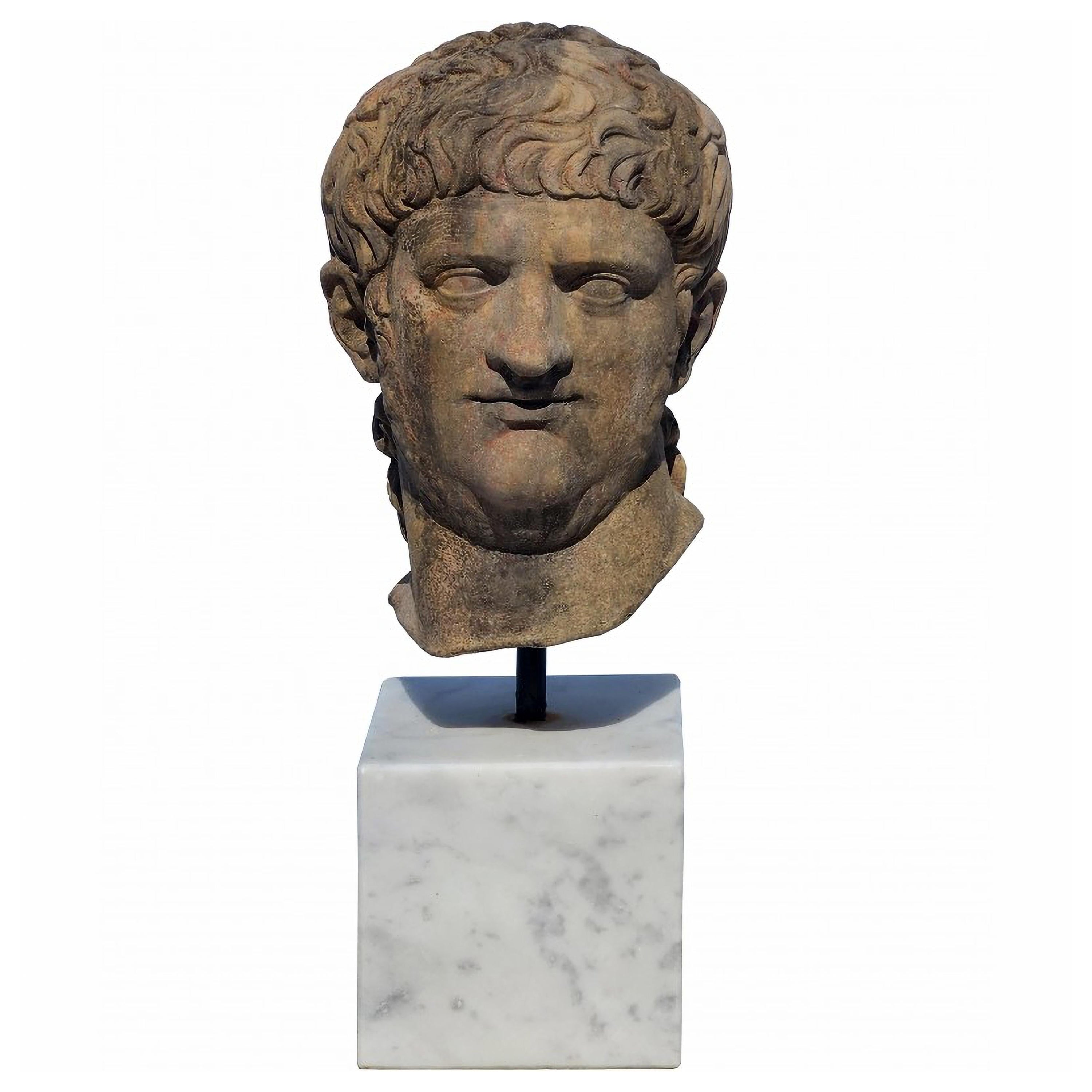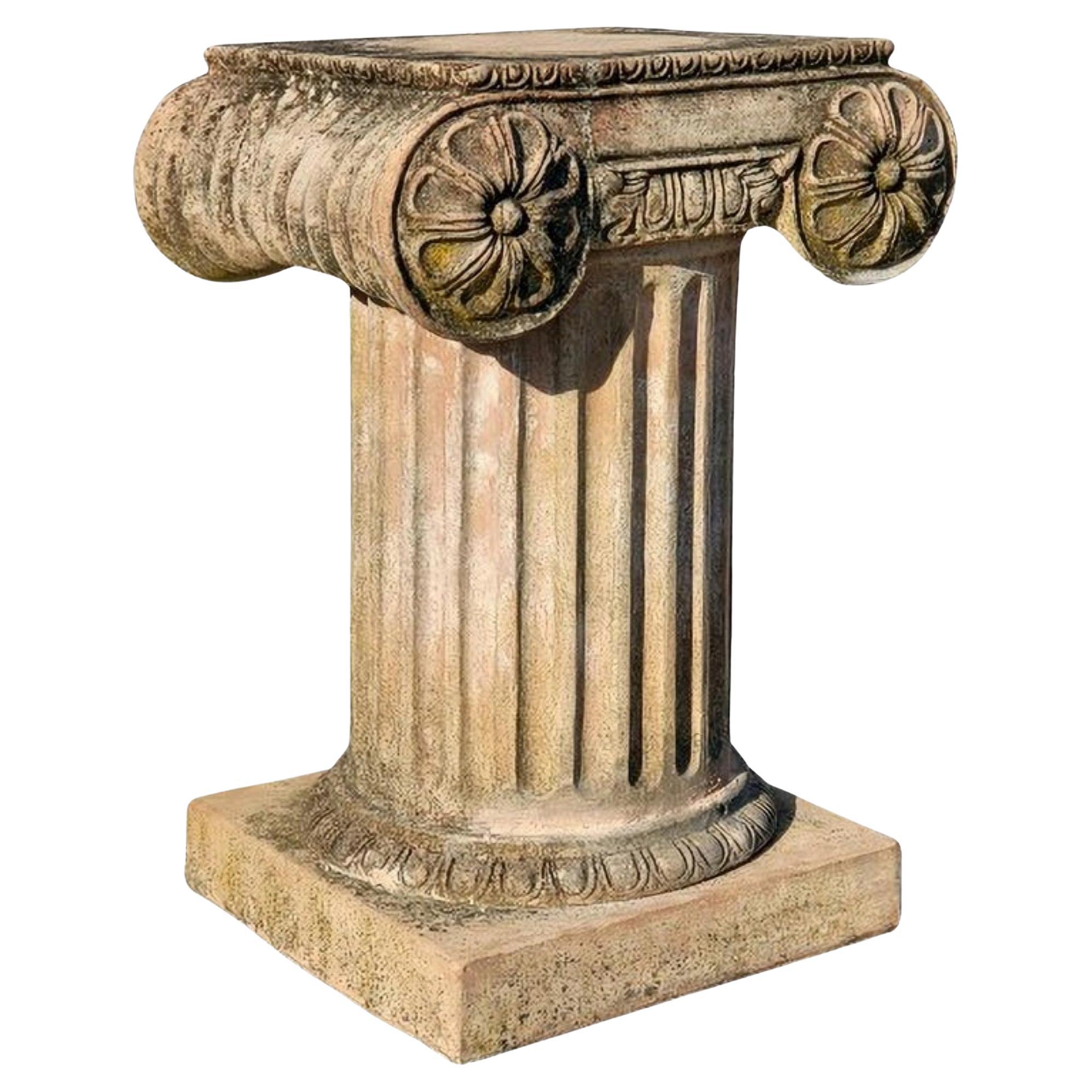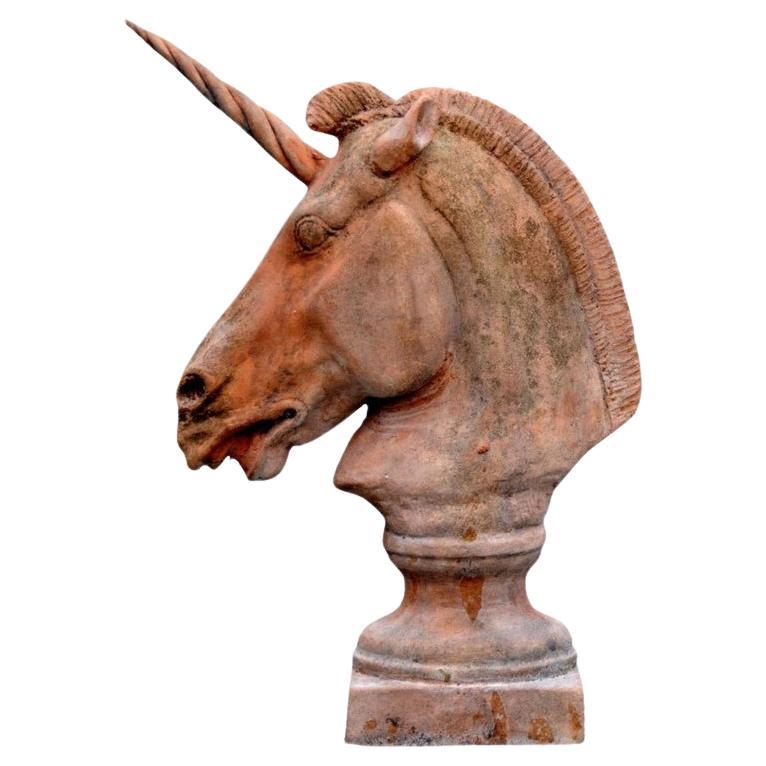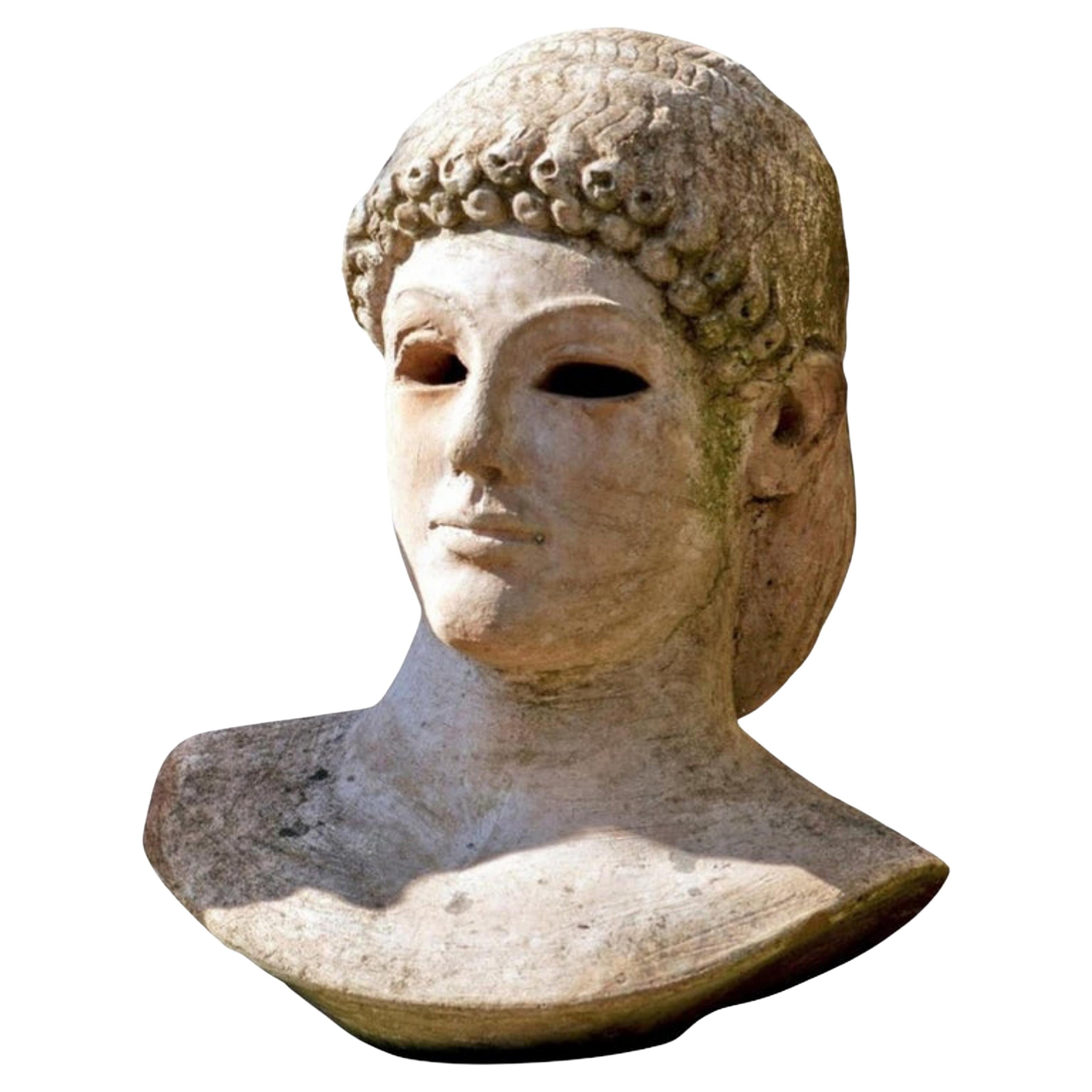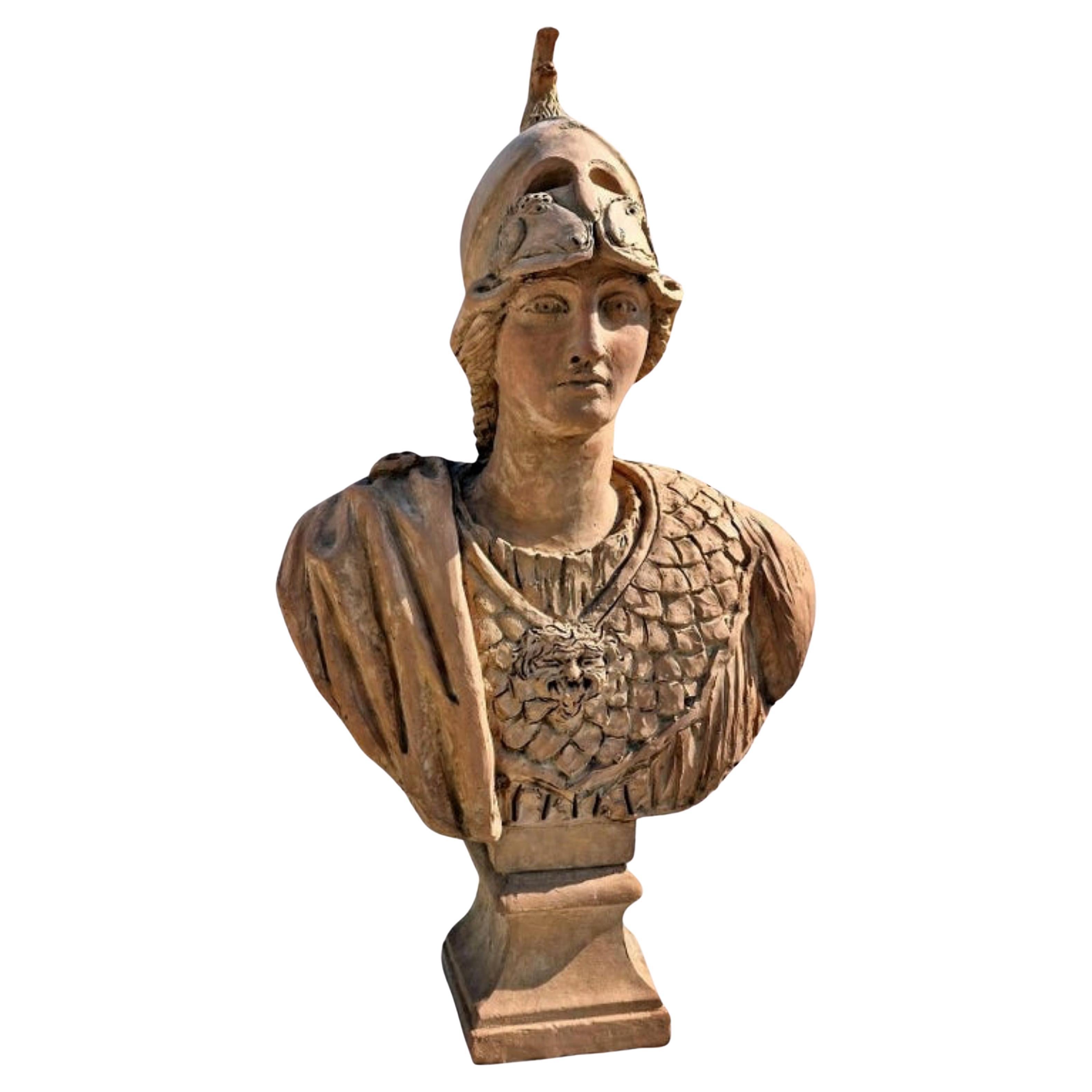Items Similar to Bust of Caracalla in Terracotta, Early 20th Century
Want more images or videos?
Request additional images or videos from the seller
1 of 7
Bust of Caracalla in Terracotta, Early 20th Century
About the Item
Bust of Caracalla in Terracotta.
Early 20th century.
Measures: height 73 cm.
Width 58 cm
Depth 30 cm
Weight 18 kg
Base diameter 22 cm.
Historical period 216 ad.
Museum where the original is exposed Capitoline Museums (Campidoglio - Rome) Hall of the Emperors.
Good conditions.
- Creator:Europa Antiques (Artist)
- Dimensions:Height: 28.75 in (73 cm)Width: 22.84 in (58 cm)Depth: 11.82 in (30 cm)
- Style:Modern (Of the Period)
- Materials and Techniques:
- Place of Origin:
- Period:
- Date of Manufacture:20th Century
- Condition:Wear consistent with age and use. Like new, very good condition.
- Seller Location:Madrid, ES
- Reference Number:1stDibs: LU5779236346242
About the Seller
4.9
Platinum Seller
These expertly vetted sellers are 1stDibs' most experienced sellers and are rated highest by our customers.
Established in 2005
1stDibs seller since 2021
231 sales on 1stDibs
Typical response time: <1 hour
- ShippingRetrieving quote...Ships From: Madrid, Spain
- Return PolicyA return for this item may be initiated within 14 days of delivery.
More From This SellerView All
- "Cesare Ottaviano" Bust in Terracotta Italian School, Early 20th CenturyBy Europa AntiquesLocated in Madrid, ESCesare Ottaviano Augusto bust in terracotta. Italian School, early 20th century. Measures: height 60 cm Width 40 cm Depth 20 cm Weight 18 kg Material terracotta.Category
Early 20th Century Italian Modern Busts
MaterialsTerracotta
- Original Italian Bust of Nerone in Terracotta, 20th CenturyBy Europa AntiquesLocated in Madrid, ESNero (Anzio 37 - Rome 68 AD) Roman Emperor (54-68 AD). Last member of the Julio-Claudian gens. Terracotta of our production, our exclusive shape. Copy of the head of the famous half-...Category
Mid-20th Century Italian Modern Busts
MaterialsTerracotta
- Column Ionic Terracotta Busts Base Support, Early 20th CenturyBy Europa AntiquesLocated in Madrid, ESColumn medium ionic order H71 cm terracotta busts base support early 20th century Beautiful column in Ionic order H 71 cm. Base for busts, sculptures...Category
Early 20th Century Italian Modern Figurative Sculptures
MaterialsTerracotta
- Unicorn in Early 20th Century TerracottaBy Europa AntiquesLocated in Madrid, ESThe unicorn in early 20th century terracotta. Measures: Height 40 cm. Width 30 cm Good conditions.Category
Early 20th Century Italian Baroque Animal Sculptures
MaterialsTerracotta
- Apollo Di Piombino Del Louvre, Bust in Terracotta, Early 20th CenturyBy Europa AntiquesLocated in Madrid, ESApollo Di Piombino Del Louvre, bust in Terracotta - Kouros Di Piombino early 20th century Measures: height 30 cm width 20 cm depth 15 cm Weight 3 kg Artist / designer / architect an...Category
Early 20th Century Italian Baroque Busts
MaterialsTerracotta
- LARGE TERRACOTTA BUST OF ATHENA FROM THE VATICAN MUSEUMS Early 20th CenturyBy Europa AntiquesLocated in Madrid, ESLARGE TERRACOTTA BUST OF ATHENA FROM THE VATICAN MUSEUMS Early 20th Century Unique and non-replicable hand formed bust Italia - Florence HEIGHT 112 cms WIDTH 58cm DEPTH 38cm WEIGH...Category
20th Century Italian Modern Busts
MaterialsTerracotta
You May Also Like
- 20th Century French Terracotta BustLocated in High Point, NCExperience the captivating allure of our 20th Century French Terracotta Bust, a stunning portrayal of feminine beauty and grace. This exquisite bust features a beautiful woman with e...Category
20th Century French Busts
MaterialsTerracotta
- Terracotta Portrait Bust of Caracalla Roman EmperorLocated in Wormelow, HerefordshireA terracotta portrait bust of Caracalla, Roman Emperor from 198 to 217 AD. The Emperor is depicted in expressive detail and wears a swathed toga which is glazed in white for a striking colour contrast. Similar portrait busts, showing Caracalla with cropped hair, stubble beard and a menacing glare, are found on display in museums across the globe including The Metropolitan Museum of Art, New York and The St. Louis Art...Category
Mid-20th Century Italian Neoclassical Busts
MaterialsTerracotta
- Auguste Henri Carli Bust in Terracotta, France, Belgium, Early 20th CenturyBy Auguste CarliLocated in Verviers, BEAuguste Henri Carli (1868-1930)-bust in terracotta, France, Belgium, early 20th century Signed A. Carli. Auguste Carli is a French sculpture, w...Category
Vintage 1920s Belgian Art Nouveau Busts
MaterialsTerracotta
- Early 20th Century Art Deco Terracotta Bust of Cleopatra by G. CarliBy Giuseppe CarliLocated in Casteren, Noord-BrabantAn Art Deco sculpture depicts Cleopatra. Beautiful polychrome green patina. On a Black Belgian marble pedestal. In a good and original condition. Made in Belgium, circa 1920-1930. By the Italian sculptor Giuseppe Carli. The Carli family is originally from Italy, Lucca, around 1910 they moved to Brussels and established the “CARLI Atelier”. When established in Belgium he also signed under his synonym Gustave Van Vaerenbergh. Many sculptors such as Dommisse, Aurili, Melani, Toogneri, Guelfi worked for Carli. They were present at all major fairs from 1910 to 1970 with sculptures in terracotta, bronze and plaster depicting subjects such as women in Art...Category
Vintage 1920s Belgian Art Deco Busts
MaterialsBelgian Black Marble
- Early 20th Century Terracotta HorseLocated in Dallas, TXGorgeous terra cotta statue dating back to the 1900s. Origin; China.Category
20th Century Chinese Animal Sculptures
MaterialsTerracotta
- Larger Than Life Terracotta Buddha Bust of Guanyin, Early 20th Century, ChinaLocated in Antwerp, BEA massive larger than life terracotta buddha bust of Guan Yin, China, early 20th century. Broken and restored with wear and tear from enduring exposure to the elements. Size: 75 cm high. Weight: 40 kg. Guanyin, Kwanyin, Guanshiyin or Guanyin Pusa is the Chinese interpretation of the bodhisattva Avalokiteśvara (the goddess of comfort and mercy). In addition, she is seen in Taoism as an immortal. The scripture dedicated to her is Dabeizhou. Guanyin is the goddess of compassion and the sea. She is one of the three saints of the western paradise, along with Mahasthamaprapta and Amitabha Buddha; they are worshiped to save departed loved ones from hell and grant them entrance to the western paradise. Guanyin Chinese name Traditional Chinese 觀音 Simplified Chinese 观音 Transcriptions Full Chinese name Traditional Chinese 觀世音 Simplified Chinese 观世音 Literal meaning "[The One Who] Perceives the Sounds of the World" Transcriptions Second alternative Chinese name Traditional Chinese 觀自在 Simplified Chinese 观自在 Literal meaning "Lord who Gazes down on the World" Transcriptions Burmese name Burmese ကွမ်ယင် IPA [kwàɴ jɪ̀ɴ] Tibetan name Tibetan སྤྱན་རས་གཟིགས Vietnamese name Vietnamese alphabet Quan Âm (Quán Âm) Quán Thế Âm (Quan Thế Âm) Quán Tự Tại Chữ Hán 觀音 觀世音 觀自在 Thai name Thai กวนอิม, พระอวโลกิเตศวรโพธิสัตว์ RTGS Kuan Im, Phra Avalokitesuan Korean name Hangul 관음, 관세음, 관자재 Hanja 觀音, 觀世音, 觀自在 Transcriptions Mongolian name Mongolian script ᠨᠢᠳᠦ ᠪᠡᠷ ᠦᠵᠡᠭᠴᠢ Japanese name Kanji 観音, 観世音, 観自在 Hiragana かんのん, かんぜおん, かんじざい Transcriptions Indonesian name Indonesian Kwan Im, Kwan She Im, Awalokiteswara Filipino name Tagalog Guanyin (ᜄᜓᜀᜈᜌᜒᜈ) Sanskrit name Sanskrit अवलोकितेश्वर (Avalokiteśvara) Khmer name Khmer អវលោកិតេស្វរៈ (Avalokitesvarak), អវលោកេស្វរៈ (Avalokesvarak), លោកេស្វរៈ (Lokesvarak) Hmong name Hmong Kabyeeb, Niam-Txiv Kabyeeb, Dabpog, Niam-Txiv Dabpog Guanyin (traditional Chinese: 觀音; simplified Chinese: 观音; pinyin: Guānyīn) is a Bodhisattva associated with compassion. She is the East Asian representation of Avalokiteśvara (Sanskrit: अवलोकितेश्वर) and has been adopted by other Eastern religions, including Chinese folk religion.[note 1] She was first given the appellation "Goddess of Mercy" or "Mercy Goddess" by Jesuit missionaries in China.[1] Guanyin is short for Guanshiyin, which means "[The One Who] Perceives the Sounds of the World."[2] On the 19th day of the sixth lunar month, Guanyin's attainment of Buddhahood is celebrated.[3] Some Buddhists believe that when one of their adherents departs from this world, they are placed by Guanyin in the heart of a lotus, and then sent to the western pure land of Sukhāvatī.[4] Guanyin is often referred to as the "most widely beloved Buddhist Divinity"[5] with miraculous powers to assist all those who pray to her, as is mentioned in the Pumen chapter of Lotus Sutra and Kāraṇḍavyūha Sūtra. Several large temples in East Asia are dedicated to Guanyin, including Shaolin Monastery, Longxing Temple, Puning Temple, Nanhai Guanyin Temple, Dharma Drum Mountain, Kwan Im Thong Hood Cho Temple, Shitennō-ji, Sensō-ji, Kiyomizu-dera, Sanjūsangen-dō, and many others. Guanyin's abode and bodhimaṇḍa in India is recorded as being on Mount Potalaka. With the localization of the belief in Guanyin, each area adopted their own Potalaka. In Chinese Buddhism, Mount Putuo is considered the bodhimaṇḍa of Guanyin. Naksansa is considered to be the Potalaka of Guanyin in Korea. Japan's Potalaka is located at Fudarakusan-ji. Tibet's Potalaka is the Potala Palace. Vietnam's Potalaka is the Hương Temple. There are several pilgrimage centers for Guanyin in East Asia. Putuoshan is the main pilgrimage site in China. There is a 33 temple Guanyin pilgrimage in Korea which includes Naksansa. In Japan, there are several pilgrimages associated with Guanyin. The oldest one of them is the Saigoku Kannon Pilgrimage, a pilgrimage through 33 temples with Guanyin shrines. Guanyin is beloved by most Buddhist traditions in a nondenominational way and found in most Tibetan temples under the name Chenrézik (Wylie: Spyan ras gzigs). Guanyin is also beloved and worshipped in the temples in Nepal. The Hiranya Varna Mahavihar located in Patan is one example. Guanyin is also found in some influential Theravada temples such as Gangaramaya Temple, Kelaniya and Natha Devale nearby Temple of the Tooth...Category
Early 20th Century Chinese Chinese Export Sculptures and Carvings
MaterialsTerracotta
Recently Viewed
View AllMore Ways To Browse
Early 20th Century Modern Furniture
The Emperor
Antique And Modern Sculpture
20th Century Terracotta Sculpture
Antique Italian Terracotta
Rome Bust
Terracotta Emperor
Caracalla Bust
Bust Of Caracalla
Bust Marie
Antique Marble Roman Busts
Hand Carved Wood Bust
Rome Bust
Antique Italian Marble Bust
Stands For Busts
Antique Carved Wood Busts
Pedestal For A Bust
Children Bust

